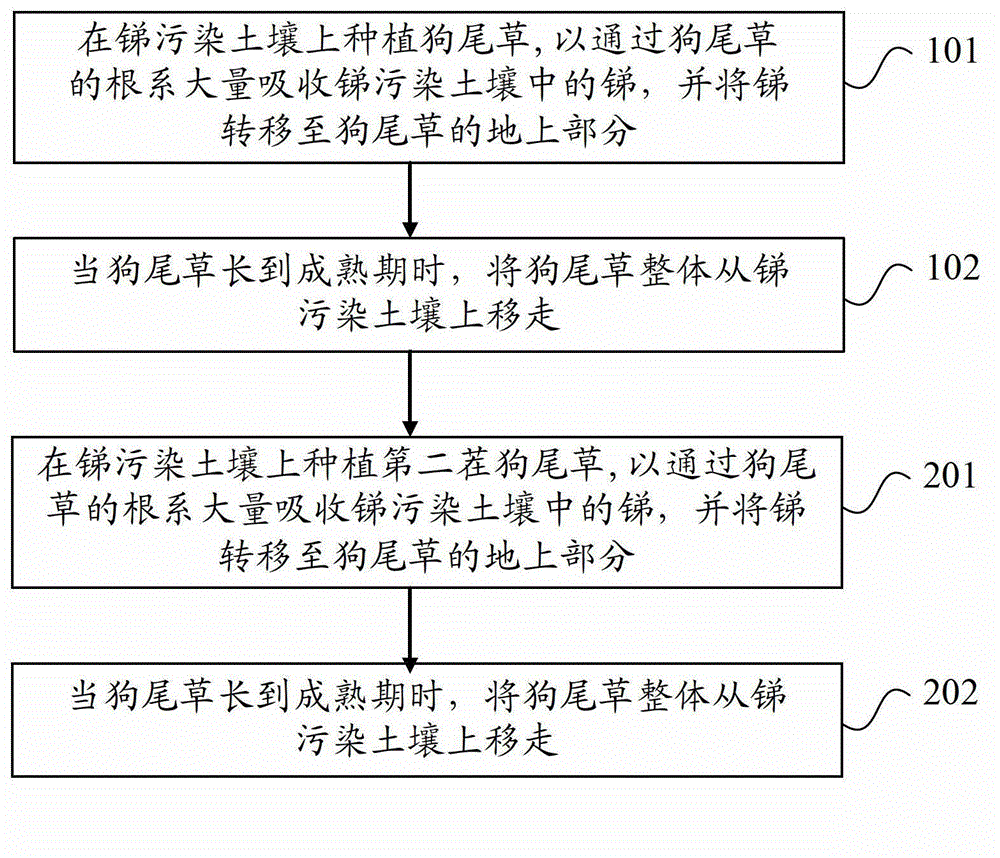Phytoremediation method for soil polluted by antimony and application of phytoremediation method
A technology for polluted soil and phytoremediation, applied in the fields of agriculture and environmental protection, can solve the problems of soil structure damage, large amount of engineering, secondary pollution, etc., and achieve the effects of beautifying the environment, enhancing anti-scattering, and low cost
- Summary
- Abstract
- Description
- Claims
- Application Information
AI Technical Summary
Problems solved by technology
Method used
Image
Examples
experiment example 1
[0036] Experimental example 1: Antimony adsorption levels of Foxtail under different water cultivation
[0037] A preliminary study was made on the adsorption of antimony by Setaria under different water cultivation methods by pot simulation experiment. Setaria was cultivated at 30%, 60%, and 80% water content respectively. The soil samples were collected from the surface soil (0-20cm) around the coal gangue pile of Xieqiao Coal Mine in Huainan mining area. The soil is yellow brown soil. The content of Sb was 4.35 mg / kg. Air-dry the soil for the experiment naturally, mash it, remove the sundries, pass through a 2mm sieve, put it into a plastic pot (20cm (diameter) × 15cm (height)), 2 plants per pot, wait for the green foxtail to mature in about three months , cutting the aboveground part along the soil surface. Rinse the aerial parts and roots of the foxtail with deionized water, dry and pulverize through 100 mesh. The processed foxtail samples were digested by chemical wet...
experiment example 2
[0040] Experimental example 2: The adsorption level of antimony by foxtail in different periods
[0041] A preliminary study was made on the adsorption levels of antimony by Setaria spp. in different periods by using pot plant simulation experiments. The soil samples were collected from the surface soil (0-20cm) around the gangue pile of Xieqiao Coal Mine in Huainan mining area. The soil is yellow brown soil, and the Sb content in the soil is 4.35mg / kg. The soil used for the experiment was naturally air-dried, crushed, and impurities were removed. After passing through a 2mm sieve, it was put into plastic pots (20cm (diameter) × 15cm (height)), with 2 plants in each pot, and the soil moisture content was adjusted to maintain a constant temperature in the field. About 30-80% of the water volume. After two weeks of balance, select Setaria seedlings with consistent growth and good growth for transplanting, 2 plants per pot, and deionized water from time to time according to the ...
experiment example 3
[0044] Experimental example 3: Remediation of antimony-contaminated soil by using foxtail
[0045] A preliminary systematic study was carried out on the antimony accumulation ability of Setaria spp. by using the pot plant simulation experiment method.
[0046] The soil samples were collected from the surface soil (0-20cm) around the gangue pile of Xieqiao Coal Mine in Huainan mining area. The soil is yellow brown soil, and the Sb content in the soil is 4.35mg / kg. The soil used for the experiment was naturally air-dried, crushed, and impurities were removed. After passing through a 2mm sieve, it was put into a plastic pot (20cm (diameter) × 15cm (height)), and the soil water content was adjusted to maintain 30-80% of the field water holding capacity. %about. After two weeks of balance, select the green foxtail seedlings with consistent growth and good growth for transplanting, 2 plants per pot, and deionized water from time to time according to the water shortage in the pot (S...
PUM
 Login to View More
Login to View More Abstract
Description
Claims
Application Information
 Login to View More
Login to View More - R&D
- Intellectual Property
- Life Sciences
- Materials
- Tech Scout
- Unparalleled Data Quality
- Higher Quality Content
- 60% Fewer Hallucinations
Browse by: Latest US Patents, China's latest patents, Technical Efficacy Thesaurus, Application Domain, Technology Topic, Popular Technical Reports.
© 2025 PatSnap. All rights reserved.Legal|Privacy policy|Modern Slavery Act Transparency Statement|Sitemap|About US| Contact US: help@patsnap.com



